Like most of you, I am currently living through an unprecedented period both personally and professionally. It turns out that I am still one of the active people and this first week, which obviously generated a lot of trouble in our daily lives, was nevertheless very rich in learning – not without difficulties – that I would like to share with you.
I propose in this article, not a checklist of everything to do in a period like this (simply because in fact I don't know anything about it) but rather to tell you about this first week lockdown with my findings, thoughts and strategies of the moment!
Wishing you a good read! 🙂
Coaching
A change of focus
For people who know me, they know that I have a point of honor to emphasize the first value of the Agile Manifesto:
People and interactions more than processes and tools
Indeed, despite its "precisely vague" aspect, it seems to me to be the guideline of our profession: to promote interactions between people above all, the tools being there only in support and support, therefore in the background .
So I admit that in this sense, I tended to move away (not to say sometimes neglect) the tool dimension to focus first on the way people interact together to then see what tool could fill their shortcomings.
In the current situation, this is unfortunately no longer possible in this way and the tool becomes an imponderable in order to be able to maintain the link and guarantee "some" interactions between people. This is one of the big changes in my current activity where my focus has largely shifted towards tools but above all respecting one of my main principles:
concern for the simplicity.
Indeed, I keep in mind that the tool remains a conversation medium first of all.
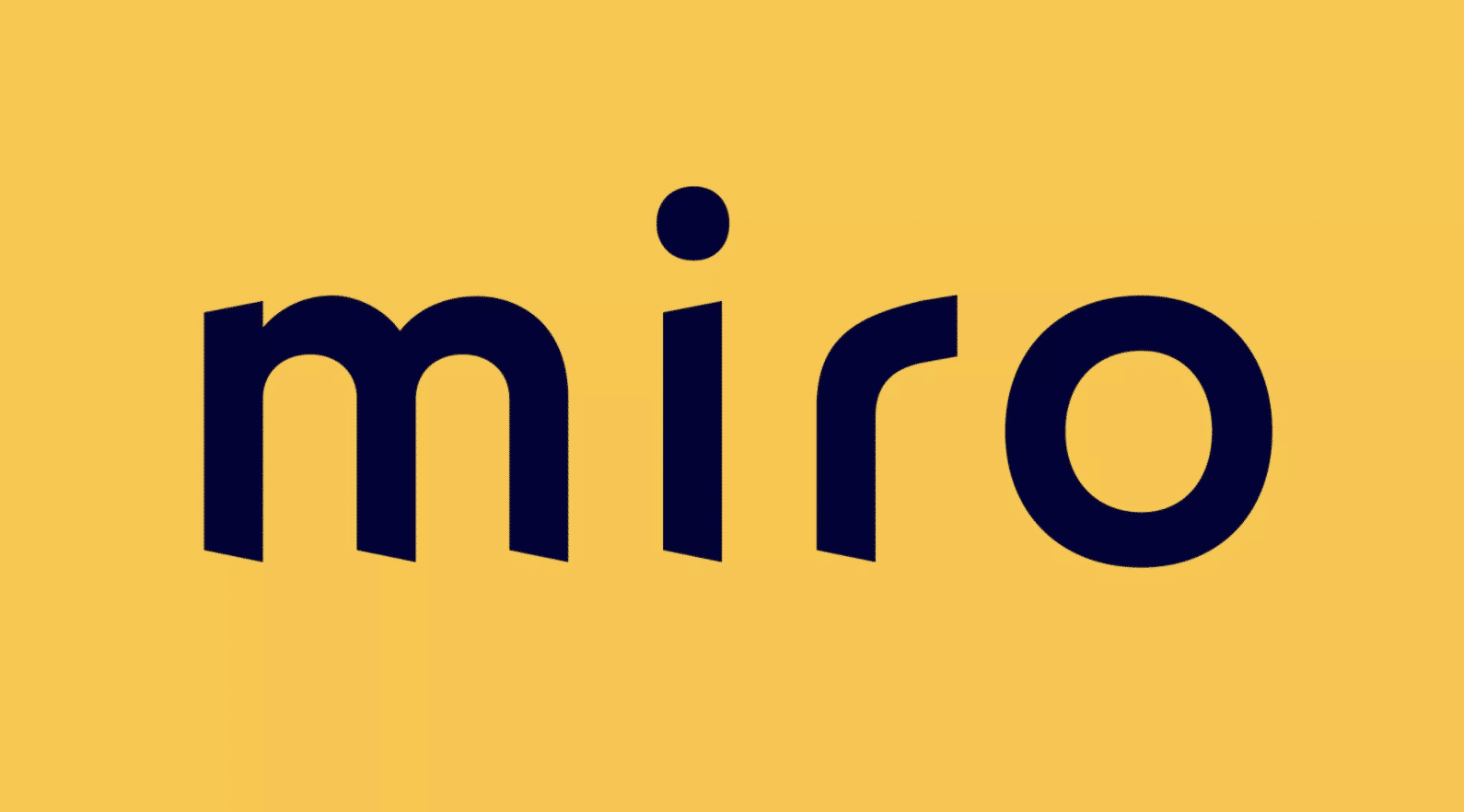
My focus then fell on Miro (formerly RealTimeBoard) for several reasons:
- I had had the opportunity to experiment a little RealTimeBoard in the past
- It has been recommended to me several times
- It seems to be one of the tools accepted (in the security sense) by my client
- It has a free version allowing the creation of 3 different spaces: which is more than enough for our current use
A change of posture

In terms of posture, it turns out I've been fine more directive lately than I'm used to. Indeed, my genes as a professional coach tend to be more in listening and questioning than in the solution. But the reason is quite simple: context has changed and it seemed important to me to take this into account.
To explain it, a model that I particularly like put me on the path: Cynefin.
Indeed, without going into the details of the model again (which I studied in This article), the current situation seemed to me like Chaotic.
In this kind of unstable context where the rules are non-existent at a given time, the strategy is to act first and foremost to stabilize the system. In other words, if there is a fire in the building (with lots of people shouting) and you are aware of safety procedures, directing people to the nearest exits and giving them clear instructions, you lower their level of anxiety and stabilize part of the system. You can then decide to do otherwise.
It is with this in mind that I took on more subjects such as:
- the choice of tool,
- the visual representation of certain paintings,
- the mechanics of how teams work,
- workshops to be organized within the teams (such as the Team Agreement).
All these elements being defined at a given moment, my idea was first to set people in motion on a path and to limit anxiety in the system. This will surely be readjusted in the coming weeks where I will probably switch again to a posture delivering more options than solutions.
The importance of taking a step back

Let's start with an excerpt from an (arranged) conversation with one of my coach colleagues:
coach : “Hi Olivier, how are you doing at the moment? »
Me "Well, like everyone else, I feel like I'm taking one step in front of the other!" »
coach : “I admit that on my side, I am a little lost. I'm not used to supporting my teams in this way. A day of teleworking here and there I can imagine it, but what I like above all is the contact with them, I can see them, help them and have a real bond with them. There, I have the impression of not being able to bring them that anymore. »
What my colleague was expressing at that moment, I also felt. Our profession is above all a profession of contact, of interaction with others. However, does this mean that nothing can be done in the current situation? On the contrary, I think that our role is always to guarantee a framework of security and support for people. We may need to take a little height to readapt to the current context.
I discussed with 2 Scrum Masters the day before confinement on the 2 main modes of support that I had been able to observe in the field and to which they could be subject:
- An approach focused on Agile practices : the most common I have the impression, often brought by transformation consultants because probably more obvious to implement. The risk is to convey the illusion of simplicity of the “Agile Method” which often turns out to be called “Scrum”, in fact.
We then explain to the teams how to make a Daily Meeting by asking 3 questions or even a retrospective by changing the formats. It's a first step that has value but which in my opinion is not sustainable over time because it is less adaptive, without a real "soul" and which can easily lead to Fake Agile.
- An approach focused on Agile principles : the one I practice most often simply to give me more flexibility in my practices. It is based on broad guidelines such as can bring 12 principles underlying the Agile Manifesto, or models like Heart of Agile, Modern Agile and Agile-Rocket. It is an intention and result orientation above all, with practical options to achieve it.
We explain to the teams the interest of feedback loops for just-in-time planning, daily collective decision-making, a real vision of progress and continuous improvement. This can translate into practices such as Sprint Planning, THE Daily Meeting, I'product increment and the retrospective in the Scrum sense, but it could also be something else.
Note: this reminds me of a discussion with Christophe Keromen where we discussed 2 change strategies:
|
I think that the current situation highlights even more the need to raise an additional level of abstraction in our support. Indeed, a coach who has only accumulated "know-how" through experience may have more difficulty adapting if he does not combine it with the "knowledge" of the Lean-Agile culture. to take a step back.
At present, the general support axes that I have chosen are the following:
- There simplicity, without surprises – so as not to generate additional disruption in an already turbulent context and increase the chances of appropriation of new features by the teams
- I'continuous learning – to best adapt to the current, uncertain situation, both from a professional and personal point of view, while respecting the constraints of each person
- There frequent product increment delivery – to reduce anxiety and the need for management control and at the same time promote the self-organization of teams
Teams
Like many of us I think, I first leaned on reading the very extensive site of Lisette Sutherland on working in distributed mode. It's a reference that I've been talking about for some time now, but given my strong taste for tools and remote work, I wasn't more interested in it. It's now done and for once, I recommend it because it's pretty well done!
Indeed, following the COVID-19 epidemic, a specific page was made with a starter kit for teams suddenly in distributed mode. It's a step that I find honorable and that has a lot of value in a chaotic situation (in the sense Cynefin) because it allows everyone to be able to get moving quickly with the first small steps. I was also greatly inspired by it to set up my first actions.
2 things in particular caught my attention:
- Best remote working practices for participants and facilitators that allow you to get into the mood
- THE Team Agreement which makes it possible to define operating rules in compliance with the constraints of each person's life
After widely sharing a quick translation of good practices (I haven't done everything) that you can find here, I had the opportunity to make a Team Agreement with one of my teams.
Team Agreement

The idea behind this workshop is simple: define a mode of operation within the team taking into account the constraints of each person's life.
Basically, I think it's a good practice to implement in a team to explain the framework of interactions; even if people are all present in physical. So in a distributed setting and with the additional constraints of the current situation (yes yes I'm talking about children 👶), I think it's inevitable!
It was also an opportunity to familiarize yourself a little with the tool to see what it could give.
For once, the animation of the workshop was quite simple because the team is small and already knows each other well. As a group, they were able to respond directly to the various questions posed to them:
- What type of information do you need to share with each other?
- What communication channels do you use to communicate? To what end?
- What is the expected response time to these channels?
- How will you know what others are working on?
- Do you have constraints during the day that deserve to be explained? When can meetings be held?
The result obtained is this:
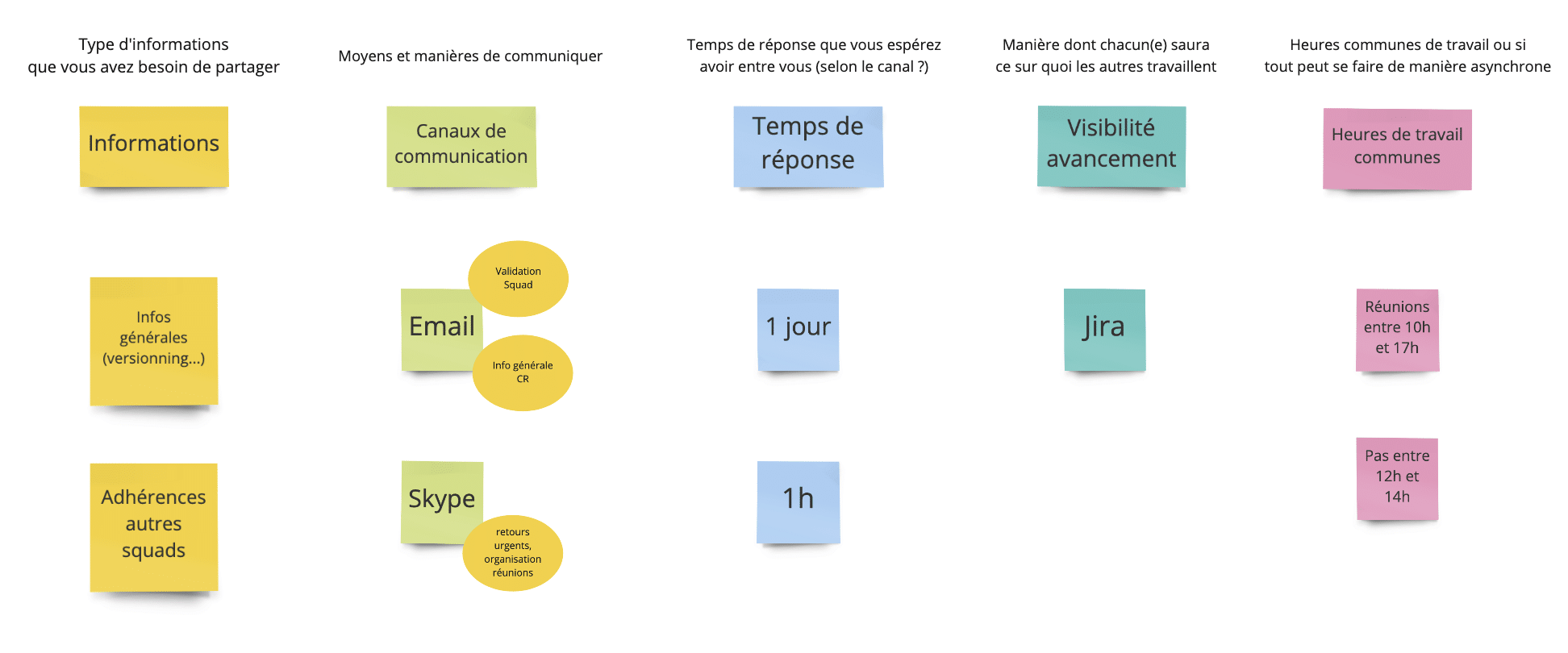
| Note : as with any workshop of this type, it is interesting to see that the reactions are often the same. At the beginning, people are not sure to see the interest because for them, this information is already known. Then through the workshop, we realize that some things need to be clarified to be formalized. This allows the team to be able to refer to this document for any new team member who might want to collaborate and to update it if necessary! |
Operation mode adjustment
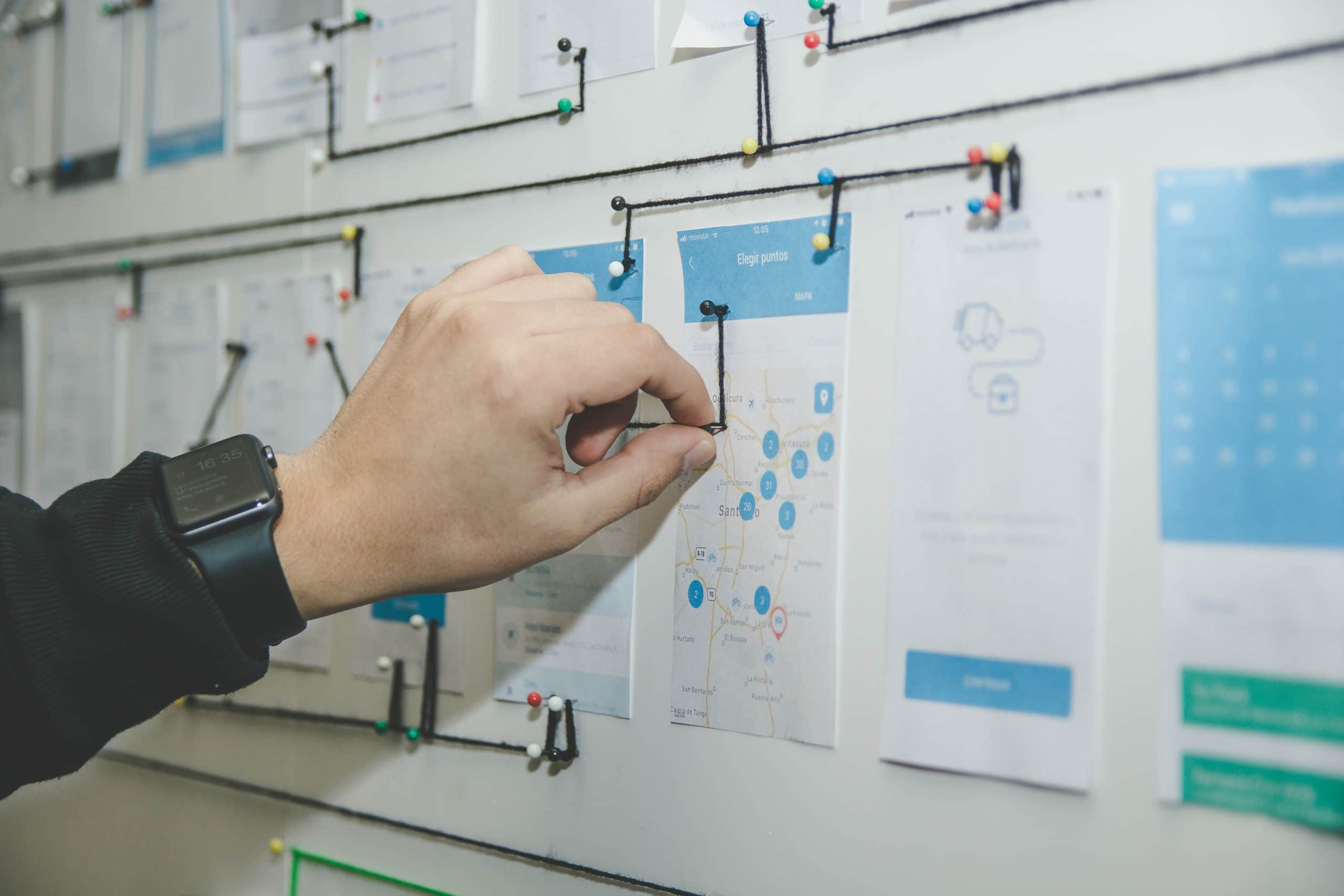
The teams I accompany are part of a scaled Agility system and it turns out that their PI Planning took place the week before. Too bad for these manufacturing plans that are shattered! 😈 Jokes aside, decisions on content have to be made by higher authorities and this is likely to be a total game-changer. Now, given the decision-making time, it seemed important to me to support the teams in some way.
Thus, to allow the teams to be able to adjust more easily in relation to these potential future changes, my proposal was to reduce the teams' feedback loops initially from 3 weeks to 1 week. My idea is to gradually take them to a Kanban mode of operation within a Scrum framework by focusing on fewer things at the same time and postponing the start of a new task until later.
This should at some point, I hope, limit the wastage of effort on work that risks becoming obsolete.
It is obviously important to keep in mind that reducing the feedback loop is not a roundabout way of putting pressure on the teams, quite the contrary: we are above all trying to limit work in progress and start to finish 🙂
Management and meetings
Adjust your posture

Here is an excerpt from an (arranged) conversation I had with a Scrum Master:
Me : " Hi ! How is it going for you right now? »
Scrum Master : “We adapt as best we can! I just have trouble seeing what's going on so I tend to call people one-to-one to find out where they stand! »
Me "And how do they experience it? »
Scrum Master “They kindly tell me that I am playing policeman. I understand this perception but how could I do otherwise? »
Me "What information are you looking for? »
Scrum Master : “I try to know the progress of each one on the various subjects. »
Me "Wouldn't there be other ways to get it? »
Scrum Master “The Daily, for example? »
Me : " Absolutely ! It's an option! And then it's also a matter of trust, don't you think? 😛 »
Scrum Master : " Yes, it's true ! »
This discussion with this Scrum Master shows that the old reflexes are still present. With the reduced visibility that remote work can bring, we can easily tend to seek out what we know and increase control mechanisms. The difficulty then lies in managing the perception of the team members on this subject or in our own perception of the situation.
A proposal that I made to her and which remains in line with the general support strategy is to use current Scrum events to obtain the information she needs, at least through:
- of Daily Meeting : to know daily the tasks on which the people work, readjust collectively if necessary
- of there Review : to see concretely what has been produced to decree an advancement, hence the interest of reducing feedback loops
- of the Retrospective : to adapt the mode of collaboration as you go along and manage the perception of your actions in relation to your team
This is obviously applicable in a physically present team, I think that the approach is all the more important in the case of a distributed mode of operation like this one. The idea being again to limit synchronization meetings as much as possible to let people work.
It's a pledge of confidence for the teams but a certain letting go for people with a management role.
To make visible

Here is an excerpt from an (arranged) conversation I had with a manager:
Me : How is it going for you at the moment?
Manager : I go to meetings a lot, even more than usual. I have several daily meetings with my management and several with my collaborators. Despite this influx of exchanges, I have the impression of not finding my account.
Me : You do not find your account there?
Manager : It's as if I were blind, in the middle of a moving river. I feel like I no longer have control. Already with Agile and the self-organization of teams it was not easy, there it is even on what there is to do that sometimes I feel lost. Maybe it was already the case when we still saw each other in physics, but my inability to produce and the inefficiency in general is all the more blatant today.
First of all, I found the honesty and sincerity of this manager remarkable. It is in difficult situations that it may seem easier to cling fiercely to what one knows than to simply lay down what is to look forward. Some might talk about letting go, maybe.
What I found interesting to observe in this situation is the following systemic loop:
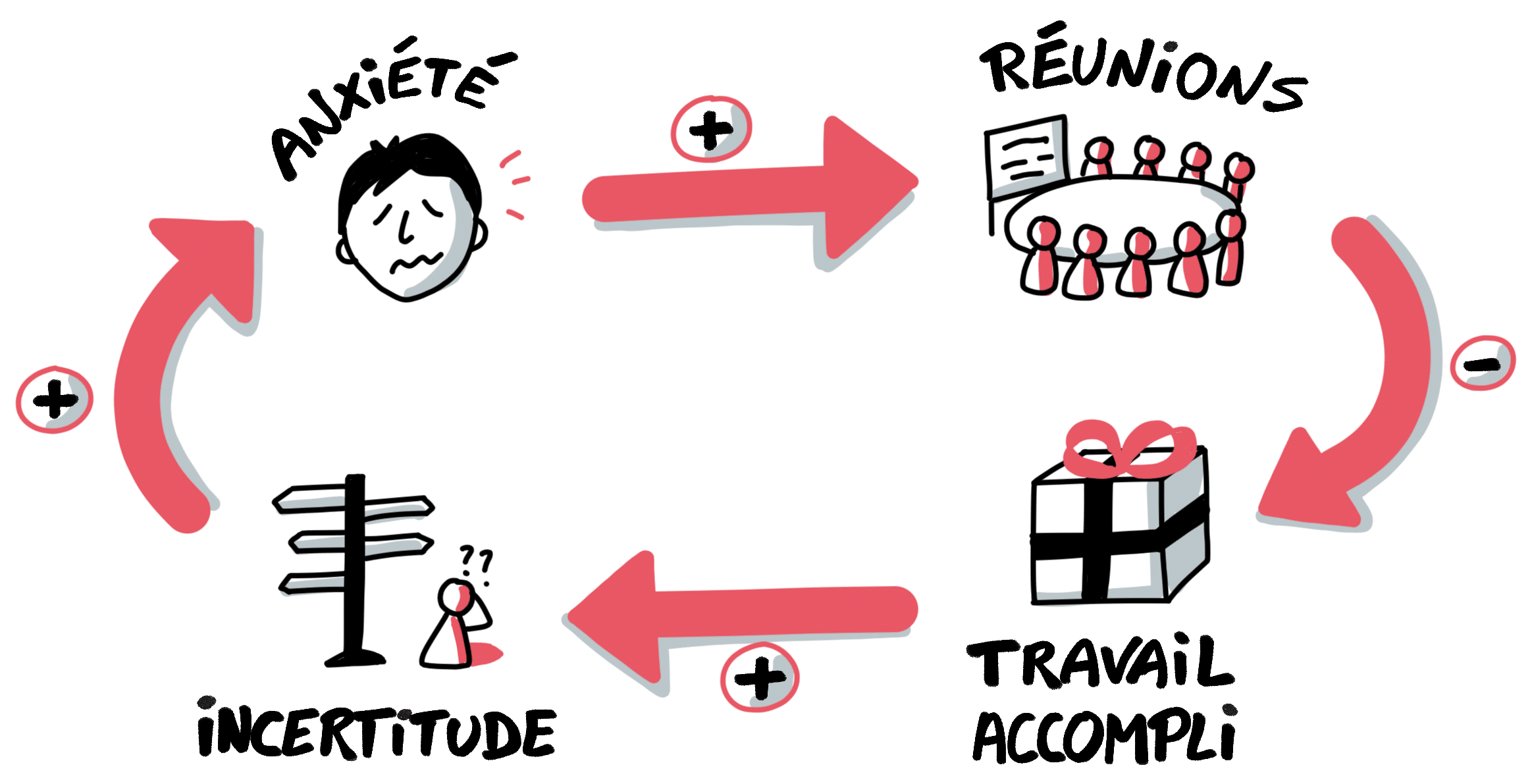
We are in the case of an amplifying loop!
My former colleague would say Arnaud Gervais !
Indeed, I think that the chaos induced by the situation caused the usual management benchmarks to be lost, which generated this momentum of meeting, supposed to restore a feeling of control over the situation.
This is why initially, I think the watchword is:
Make the situation and the work to be done visible
This could then translate to:
- A visual board to follow what is important: it remains to define the type of information they need
- A space for raising alerts / questions / questions on the part of employees, accessible and available at all times, to allow them to act as best they can without having to wait for a meeting
These 2 elements should make it possible to increase visibility on the situation and allow more informed decisions to be made. At the same time, seeing things should decrease the need for meetings and allow more efficiency. The idea behind is that Management also applies Agile concepts rather than just asking teams.
Fractally, this should be able to apply to all other levels as well.
Facilitate exchanges

I myself attended these meetings with management:
- 20 people
- connected in audio only
- with rather poor line quality
- without facilitation.
I suppose you can imagine the content of this moment which generates, at least for me, an almost immediate disengagement. So I have to imagine that I'm not the only one. This is also one of the reasons why I preferred to trigger one-to-ones, from which the above conversation is taken, which for me have much more value.
A support axis that seems relevant to me to implement is the trade facilitation during the meetings, being able to draw inspiration from the ideas of This article.
The associated visual support could then look like this:
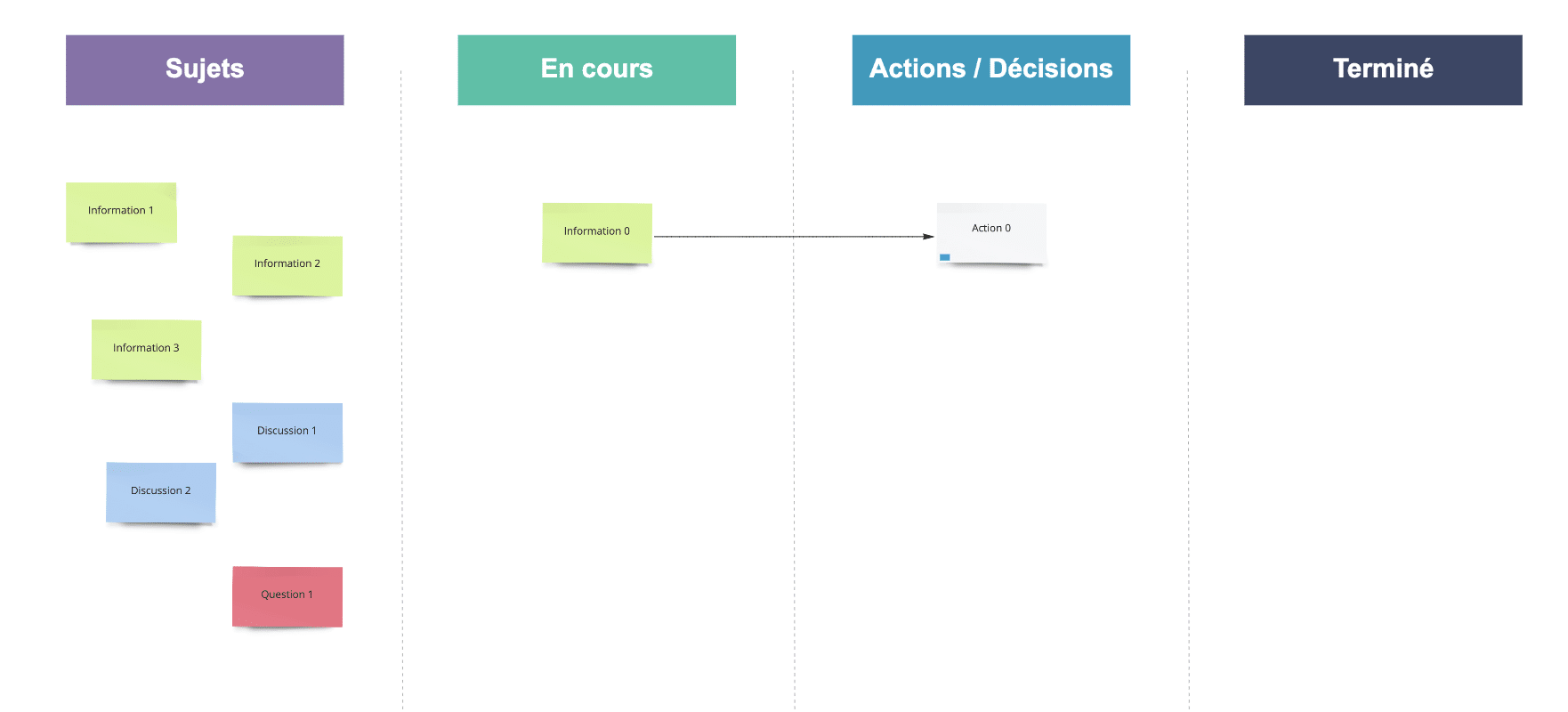
This table should make it possible to focus the exchanges and lead to positions being taken (Actions / Decisions).
The Post-its present in this 3rd column will then be able to feed the following management table:
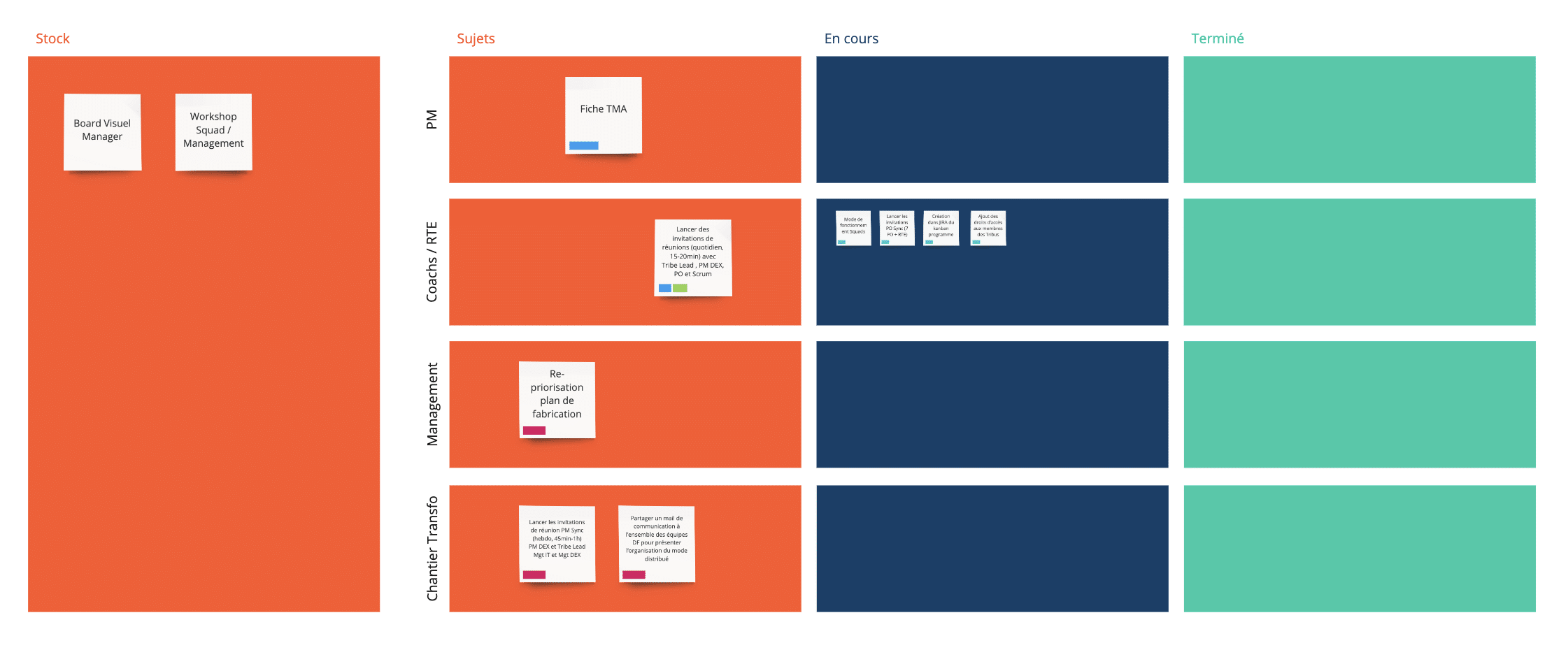
The idea behind this table is quite simple:
- Clarify a state of progress with a simple 3-column process
- Identify carrier groups so everyone can assign themselves topics in their own backlog
- View separate stock of the backlog of each group of carriers to avoid scattering
- Limit work in progress limiting the space available for Post-its
This should, I hope, help to structure the exchanges a little better in order to direct them to action and not just to fuel the debates.
In pictures
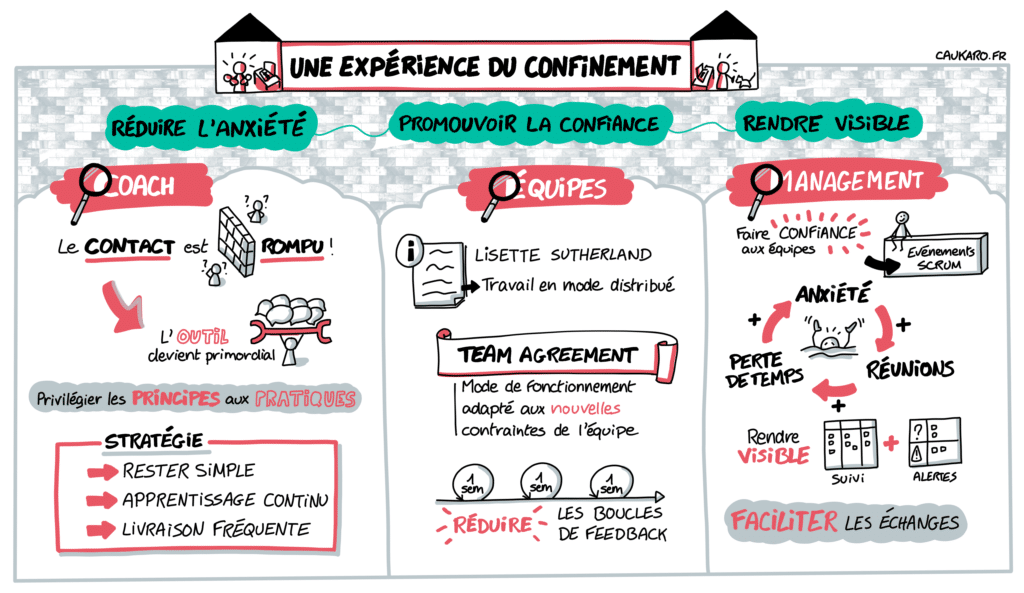
Conclusion

In summary, this first week of confinement was a trying experience! Indeed, I have the impression that my mental load has been much greater, probably because of latent anxiety in me and in my interlocutors. I think it's in times like this that an organization's resilience is tested. Moving from a culture of control to a culture of trust is not easy, but perhaps this is our chance to experiment, day by day, small step by small step.
Moreover, it is now that everything that might have seemed impossible in the past seems more realistic – like accepting to release certain functionalities from a perimeter that has been frozen for months!
Now you will understand, In this climate of uncertainty, in my opinion, there are no ready-made answers. However, in each situation it is possible for us to provide an answer to take the next step. In my case, my current strategy is simple: best reduce the anxiety of my surroundings and promote trust by making the situation visible.
I think that despite the difficulties imposed on us by the COVID-19 pandemic, we have the possibility of emerging from it by experimenting with things that we would not have tried in other conditions:
- take time for yourself to think about what is really important,
- appreciate the interactions that we can have with those around us
- and do what can bring (us) value.
With that, take good care of yourself and, as the Tao Te Ching would say, I wish you:
Dto become as flexible as water which always finds its way by adapting to the terrain.







One Response
Thank you Olivier, for this always relevant sharing, full of common sense
Take care of yourself.